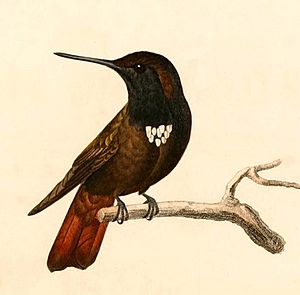Black-hooded sunbeam facts for kids
Quick facts for kids Black-hooded sunbeam |
|
|---|---|
 |
|
| Conservation status | |
| Scientific classification | |
| Genus: |
Aglaeactis
|
| Species: |
pamela
|
 |
|
The black-hooded sunbeam (Aglaeactis pamela) is a type of hummingbird. It belongs to a group of hummingbirds called "brilliants." This bird lives only in Bolivia, a country in South America.
Contents
What's in a Name?
The black-hooded sunbeam is a unique bird. It is the only species in its group, which means it doesn't have any close relatives that are also called "sunbeams."
What Does It Look Like?
This hummingbird is about 12 centimeters (about 5 inches) long. That includes its straight, black bill, which is about 15 millimeters (about 0.6 inches) long.
Male black-hooded sunbeams weigh around 5.2 grams. Females are a bit heavier, at about 5.8 grams.
The adult male is mostly a purplish-black color. Its lower back and rump shine with golden-green to bluish-green colors. It also has a small white tuft of feathers in the middle of its chest. Its tail is a reddish-brown color with darker tips.
Female black-hooded sunbeams look similar to males. However, their colors are not as bright. Their lower back and rump are also less shiny. Young birds are a bit browner than adults. They have a smaller chest tuft and their tail has a slight olive color.
Where Does It Live?
The black-hooded sunbeam lives only in the Andes mountains of northern Bolivia. You can mostly find it in the areas of La Paz and Cochabamba.
These birds usually live at high elevations. They prefer places between 2,500 and 4,200 meters (about 8,200 to 13,800 feet) above sea level. Sometimes, they can be seen as low as 1,800 meters (about 5,900 feet).
Their favorite homes are cloud forests. They also live in humid or semi-humid mountain scrublands.
How Does It Behave?
Moving Around
Scientists believe the black-hooded sunbeam stays in one area. It might move to different elevations depending on the season.
What It Eats
The black-hooded sunbeam mainly eats nectar from flowers. It doesn't just hover; it often clings to flowers while it feeds. It also eats small arthropods, which are tiny bugs.
Family Life
The breeding season for the black-hooded sunbeam is thought to be from September to March. However, not much is known about their nests or eggs. Scientists are still learning about how they raise their young.
What It Sounds Like
We don't know a lot about the sounds these birds make. People have heard them make a high-pitched "zeet-zeet-zeet" sound. They also make other calls when they are fighting with other birds.
Is It in Danger?
The IUCN (International Union for Conservation of Nature) has looked at the black-hooded sunbeam. They say it is a species of "Least Concern." This means it is not currently in danger of disappearing.
Even though it lives in a small area, its population seems to be stable. Human activities don't seem to affect the black-hooded sunbeam much, at least for now.
See also
 In Spanish: Aglaeactis pamela para niños
In Spanish: Aglaeactis pamela para niños


